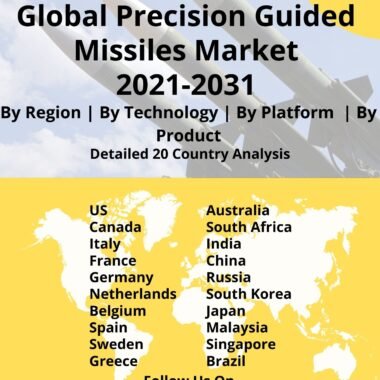Description
Targetting PODS Market
Frequently Asked Questions of Targetting PODS market
In order to find reflected pulsed laser light from a predetermined target, laser-guided bombs need a device called a “laser spot tracker” to do their job. This enables the targeting pods market system of an aircraft to zero in on that particular target. Simplest spot trackers, like the Pave Penny pod, only include a laser sensor and no actual laser. A laser rangefinder, which is a laser beam that can compute the precise range to a target and transmit that information to the navigation/combat system, is incorporated into several aiming systems. Many targeting pods or installations can conduct both ranging and tracking because they employ the same sensor that the laser spot tracker uses to pick up the reflected rangefinder signal. These are referred to as marked target seekers and laser rangers (LRMTS).
The aircraft can designate its own targets or designate for other friendly troops with the use of some targeting systems that feature a laser that can identify a target for laser-guided missiles. The fundamental electro-optical (EO) sensor, which aids the aircrew in locating and identifying targets, is essentially a closed-circuit television camera that typically has a magnifying lens. Many EO sensors have low-light light-amplification devices for usage at night and in bad weather. To help locate and recognize targets in the dark, some pods add forward-looking infrared (FLIR) to their basic visual EO. These devices are occasionally referred to as infrared search and track sensors.
Strike fighters need to be aware of numerous systems, frequently all at once. It would ease their burden and give the crew the flexibility to carry out various missions if they could have equipment that enhances target recognition and threat tracking. A single pod houses all of the sensors necessary to carry out a variety of tasks, including target detection, recognition, identification, and laser pointing at a distance, EO tracking of multiple stationary targets, auto-detection of numerous moving and flying targets, and precise target location extraction and pointing. A laser designator, a laser spot detector and tracker, a laser marker, as well as MWIR, SWIR, and color sensors are all included in one pod in modern targeting pods.
Major factors driving the Targeting pods market size
There is increasing demand for UAVs in military applications. Due to the emergence of drone technology and several other capabilities of it there is a strong demand for UAV in numerous countries. Numerous countries are registered for UAVs, due to an increase incident of enemy border crossing and trespassing. UAVs are designed to perform many activities such as surveillance, reconnaissance, and intelligence in various missions. Targeting pods market forecast, demand for targeting solutions specific to UAVS will increase the growth of the targeting pods market size and will be one of the key driving force.
Trends influencing the targeting pods market growth
Targetting pods market growth, miniaturization of targeting pods is an important technology trend as compact lightweight pods will be required for UAV integration. Targetting pods market trends, the continuing quest for miniaturization and low power consuming targeting pods solutions will be in high demand.
Targetting PODS Market Forecast & Dynamics
Targetting pods market analysis, the increase in defense spending will encourage targetting pods market growth. Targetting pods market analysis, the procurement will also be driven by prevailing geo political conditions in Europe and the Asia Pacific and increasing use of targeting pods for surveillance and intelligence gathering.
Targetting PODS Market Analysis for Recent Developments
Targetting pods market reports, a pod that appeared to be similar to one that was beneath the wing of another of these drones that crashed in Syria almost two years ago was aboard the U.S. Air Force MQ-9 Reaper unmanned aircraft when it crashed in Romania last week. This pod is still a mystery to some extent. On July 14, the aforementioned MQ-9 crashed into a farmer’s field about three kilometers (or 1.86 miles) south of the 71st Air Base of the Romanian Air Force in Campia Turzii. Uncertainty surrounds the incident’s cause or reasons, which the Air Force confirmed and claimed were being looked into.
Targetting pods market reports, Thales has received an additional order from France for 21 TALIOS targeting pods, which will be mounted on the country’s Dassault Rafales that meet the F3 and F4 standards. By 2025, the French Air and Space Force and the French Navy will have 67 TALIOS pods in service, according to Thales. The ‘Vision Permanent’ feature, which “superimposes real-time video on a 3D map,” is also included in the most recent version. According to Thales, the TALIOS pod will allow Rafale F4-standard aircraft to carry out air reconnaissance as well as ground/surface assault missions. The pod may rapidly convert into target acquisition and tracking mode after performing a wide-area search and identifying targets.
Eglin’s Integrated Test Team performed the first operational test across multiple platforms to successfully detect a target using shared Infra-Red Search and Track sensor data. The IRST21 infrared sensor was utilised by an F-15C Eagle and an F-16 Fighting Falcon, both of which were fitted with Lockheed Martin’s Legion Pod, to find a target. In order to passively determine target position without using radar or other active range sources, the aircraft were then able to communicate that sensor data across the Advanced Datalink of the Legion pod.
The market is positioned as a critical component within modern military aviation, exemplifying the fusion of cutting-edge technology and strategic precision. Targeting Pods are advanced electro-optical systems mounted on aircraft that provide pilots with enhanced targeting, surveillance, and reconnaissance capabilities. These pods play a pivotal role in enhancing the accuracy and effectiveness of airborne munitions, enabling pilots to identify and engage targets with precision. The market is witnessing a surge in demand for Targeting Pods driven by the evolving nature of contemporary warfare, marked by the need for rapid and accurate target acquisition. Technological advancements in TPODs include high-resolution sensors, infrared cameras, and laser designators, facilitating day and night operations in various weather conditions. The integration of artificial intelligence and data-sharing capabilities further enhances the situational awareness of pilots, contributing to mission success.
Geopolitical considerations and the growing complexity of military operations are key drivers influencing the market dynamics. Nations worldwide are investing in advanced targeting pod systems to bolster their air superiority capabilities and ensure precise targeting in both conventional and asymmetrical conflicts. The global Targeting Pods market in 2023 signifies a paradigm shift in air combat strategies, emphasizing the importance of precision-guided munitions and the role of advanced electro-optical systems in achieving military objectives with maximum accuracy and efficiency.”
![Global_Targeting_PODS_Market_2024-2034[1] Global_Targeting_PODS_Market](https://aviationanddefensemarketreports.com/wp-content/uploads/2022/08/Global_Targeting_PODS_Market_2024-20341.jpg)






